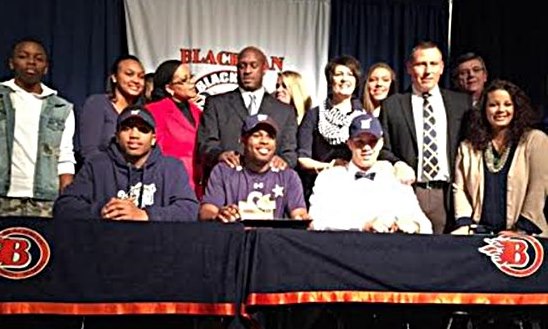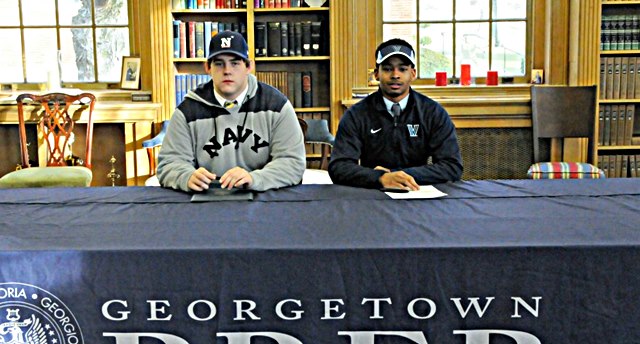
The end of the 2016 season for Navy — simultaneously so successful and so defined by setbacks — is a time for mixed emotions and an ability to hold competing tensions together.
The end of the 2016 season should make Navy fans laugh, and it should make them lament the big fish that got away — Army first, then Louisiana Tech in the Armed Forces Bowl.
This is a time for rejoicing and giving thanks in Navy’s most prosperous football era, which secured new and even more inspiring accomplishments this season. It’s also a time to expect more from a portion of the roster, which did enough to succeed in the first three months of the journey but was exposed for what it was in December.
The balance of the season was spent celebrating the feats of Ivin Jasper, Will Worth, and the rest of a Navy offense which performed above and beyond the call. The Midshipmen’s offense transcended expectations and limits in 2016, thriving with a backup quarterback who entered Opening Day not expecting to take the baton from Keenan Reynolds. The constant ability to outperform expectations on an absolute scale was impressive enough; all the stats Navy racked up would have been viewed as overachievement if Tago Smith had presided over them.
Doing everything it did without Smith? Navy’s offense was truly remarkable in 2016. Winning a first division championship with a steady stream of high-output offensive displays was — and is, and always will be — the signature accomplishment of this season.
For anyone who worried if the house was going to fall down this season without Reynolds — and who then thought the Midshipmen were in massive trouble when Smith went down in Week 1 (*raises hand as a guilty party*) — Niumatalolo and Jasper reminded everyone in college football how skilled they are in terms of coaching with (and around) limitations. One can only celebrate the continued dexterity and textured acumen of Navy’s coaches, now division champions and the envy of the rest of the AAC West.
This need to celebrate the Navy offense is precisely what allows for a little laughter in the wake of the Armed Forces Bowl.
Zach Abey, Worth’s replacement, hit his stride as the leader and custodian of the offense. Then he got injured, forcing Malcolm Perry to enter the game near its very end. With a fourth-string quarterback, many programs would have been lost at sea (word choice intentional). Not Navy.
Perry promptly scored on a long fourth-quarter touchdown run, a way of letting the whole Navy family know that in 2017, everything will be okay. It’s just about impossible to leave this 2016 thinking Navy will suffer on offense in the near future. Every quarterback plugged into the game performs well at this program. The Army game was clearly an aberration brought about by a small amount of preparation time. This was the real Navy offense again, an important development the Midshipmen and their fans needed to see in the Armed Forces Bowl. Checking that box alone makes it much easier to swallow a loss.
What also makes it easier to absorb this result against Louisiana Tech? The simple realization that Navy was crushed by forces outside its control.
From the injuries, to the reality of suffering those injuries in the AAC Championship Game — which, if not played, would have left Navy better rested for Army — to the ridiculousness of watching its fourth-string quarterback breeze to the end zone late in a game, Navy did all it could on offense even as the fates refused to cooperate.
That last part — not being in full control — can only bring a shrug of the shoulders and a hearty laugh. One can be disappointed at larger forces in the cosmos, but Navy’s offensive effort in 2016 was so resplendent that there’s precious little criticism to go around.
*
If Navy’s offense — and its unearned, undeserved misfortunes — doesn’t deserve to catch any heat, Navy’s defense is what deserved frustration, anger and agony from fans — after the AAC title game, the Army game, and after this past Friday.
I didn’t write much about the defense this season because it became apparent very early in October that this was likely to be the defense Navy lived with during the whole run.
It’s true that the defense produced a touchdown against Houston; held Memphis under 30, which wasn’t bad at all; and stopped a two-point play by Tulsa to make a 42-40 win (and the division title) possible, which all represented contributions to the larger team effort.
Nevertheless, this was a defense which had to thank its lucky stars that the offense was able to score at least 42 points in every AAC West home game of consequence this season. September, and that goal-line stand against UConn, represented this defense’s finest hour, but as soon as the non-Tulane AAC West schedule rolled around, Navy’s defensive eleven entered a realm in which they weren’t expected to achieve much. The Midshipmen had to count on their offense in a way a tennis player has to count on holding serve and winning a set with that same monster serve in a tiebreaker… and one or two return points, just enough to get the job done.
Through November, this approach worked.
Then, in December, when the offensive injuries — and first-half turnovers — arrived, the Midshipmen lost their margin for error.
You saw what happened in all three December games.
*
The offensive injuries could not be controlled — one can only laugh a laugh of exasperation and bewilderment under such circumstances — but Navy always could have made a few extra plays on defense once its offensive equation changed for the worse.
Navy put Army in that third and seven late in the fourth quarter in Baltimore, but allowed six yards on a shovel pass and a conversion on fourth and inches.
Navy had Louisiana Tech quarterback Ryan Higgins dead to rights on a number of plays in the second half of the Armed Forces Bowl, only to allow him to slip away. If Higgins hadn’t escaped, dubious pass interference penalties against Navy wouldn’t have been able to be called. After two months of being carried by the offense, the defense — given chances to either preserve a fourth-quarter lead (Army) or rise up in a tied game (Louisiana Tech) failed to step up. The early fourth-down conversions allowed against Temple in the AAC title game set a tone for that contest, so that when Worth got knocked out, Navy was well behind instead of being tied or ahead.
Yes, Navy ran into horrible injury luck and got the short straw on officiating and other in-game plot twists in December. This three-game losing streak — and the end of The Streak against West Point — had a lot to do with events Navy didn’t deserve.
Yet, one can clearly see how untimely defensive lapses created domino-effect sequences in December. Living right in October and November — in a world when just a handful of high-impact plays was enough to swing a game or preserve a narrow lead — did not guarantee anything for Navy’s defense in December.
True, one knew in the middle of the season that Navy’s defense was not going to be a pillar or cornerstone of this team, but the lack of a response in the face of the awareness that it had to be better (once Will Worth got injured) is undeniably disappointing. It begs for a better and more sustained response in 2017.
That last point merits at least some criticism and frustration, because it shows there was something (just not everything) Navy could have done to avoid losing to Army or in a bowl game. There was something Navy could have done to change the late-stage trajectory of this still-very-successful (but not as successful as normal) season.
Navy fans should laugh at the absurdity and unfairness of the injury plague which changed the course of service-academy football in 2016 — you’re welcome, West Point — but losing a bowl game on a day when Zach Abey and Malcolm Perry combined to score 45 points? That’s worth a cry of the heart — maybe not tears spilled, but a pained utterance of exasperation.
Thanksgiving for a first AAC West title is still the number one feeling I feel in response to a season which so many other coaching staffs would not have handled as well, from Game 1 through Game 14. Nevertheless, the lack of an extra pinch of defense in important situations reminds us that for all the ways in which Navy was bitterly unlucky at the end of 2016, the defense had a chance to overcome that lack of fortune… and couldn’t.
In 2017, let’s see if Navy’s defense can stand in the gap and thwart misfortune with a little more resilience.



